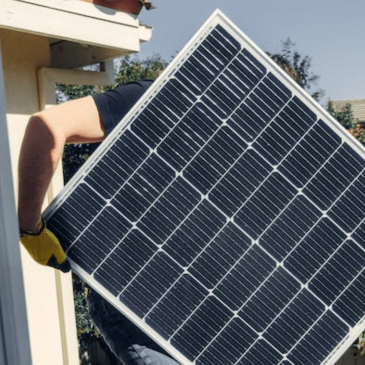A Glossary of Useful and Common Terms Associated With Residential Solar
Solar installers, like many professionals who work in the technology field, can sometimes confuse their customers when they use industry jargon. Most don’t realize that they could be compromising their sale by keeping things too complicated for the layman to understand, and this is unfortunate because choosing not to go solar not only hurts the solar installer, but also the homeowner.
If you are thinking about going solar, then it is important to ask your salesperson any question that comes to your mind. Ask them to simplify their wordage, so you can better understand exactly what it is that you are buying and how it works. You’re paying for your solar system, so you have the right to know as much as possible about it.
With that said, it also helps to do your own research into solar energy because this will give you a good foundation to work with. And like any solid education, it all starts with getting familiar with the glossary of common words and terms. Here are the basic terms you’ll hear when discussing residential solar with your salesperson. Understanding them ahead of time will help you make a more informed decision.
Array
When multiple solar panels are wired together, this is called a solar array.
Azimuth
When discussing your roof with your solar installer, you might hear them use the word “azimuth.” This is the angle between your roof and true north, and it is measured in degrees. In more simplified terms, it is the direction your roof faces.
Interconnection Agreement
An interconnection agreement is essentially a contract between the homeowner and their local utility allowing the homeowner to connect their solar system to the electric grid.
Inverter
The inverter is the component of the solar system that converts the energy that is generated by your solar panels into usable electricity that is used to power your home. The inverter is typically installed inside the home, near the electrical panel box. Some newer panels have micro-inverters installed directly on them. These have been shown to optimize energy production because central inverters are designed to optimize for the weakest panel in the array.
Kilowatt-Hour (kWh)
Kilowatt-Hour is the standard unit for measuring electricity use. This is what the utility company uses to determine your monthly bill. According to the U.S. Energy Information Administration, in 2021, the average electricity consumption for a U.S. residential utility customer was about 886 kWh per month.
Monocrystalline
Some solar panels are called monocrystalline solar panels because they are made up of monocrystalline solar cells. These cells are made from a cylindrical silicon ingot that is then sliced into wafers used to form the cells. Because the silicon used is grown from a single, pure silicon crystal, monocrystalline panels offer greater efficiency and can produce more power per square foot of panel space.
Net Metering
When a solar system that is connected to the electrical grid produces more energy than the home uses, the excess power is sent to the electrical grid and redistributed where it’s needed. A net meter records the energy sent compared to the energy the home receives from the grid during the nighttime and then either credits or charges the homeowner according to their local rates and rules.
Off Grid
When an installer asks if you want to be off grid, they are asking if you want your home to be entirely dependent on solar energy. Off grid means your home is disconnected from the national electrical grid and thus, will require battery storage to ensure that your home has electricity available for use after the sun goes down.
Payback Period
A solar system’s payback period is the length of time it is expected to take for the homeowner to reach their break-even point. For the average solar homeowner, it takes about seven years for them to break even.
Photovoltaic (PV)
Solar panels are photovoltaic devices. This means that they generate electricity from sunlight through an electronic process that naturally occurs in certain types of materials. These materials are what are known as semiconductors.
Polycrystalline
Polycrystalline solar panels feature cells that are made of several crystals of silicon which are melted together to form wafers. These types of solar panels tend to be less expensive than monocrystalline, but they are also less efficient.
Power Rating
Every solar panel has a power rating. This is the number of watts that the panel is expected to produce under ideal sunlight and temperature conditions.
Solar Panel Efficiency
A solar panel’s efficiency rating is indicative of how well a panel converts sunlight into electricity. Most solar panels have an efficiency rating between 14 and 16 percent, but some higher efficiency panels can reach as high as 20 percent or more.
Temperature Coefficient
Temperature can affect a solar panel’s performance, with higher heat causing a decline in efficiency. A solar panel’s temperature coefficient relates to how much of a drop off the panel experiences at a certain degree. For example, most solar panels have a temperature coefficient of around -0.3% / °C to -0.5% / °C. If a solar panel has a temperature coefficient of -0.5%, then for every 1°C above 25°C, the solar panel sees a decrease in efficiency by 0.5%.
Thin Film Solar
Thin film solar is a newer type of PV solar technology in which very thin layers of PV material are used to create lightweight, often flexible sheets of solar energy-producing modules. Thin-film solar tends to be more affordable and more versatile than conventional solar panels, but they are also less efficient and have been shown to degrade more quickly over time.
Zero Net Energy
A zero net energy home is one that consumes the same amount of energy as its solar system produces.
Now that you are armed with a better understanding of these basic terms commonly used by solar installers, you can have a better idea of what your installer is talking about while they are presenting their sales pitch. This will help you avoid surprises and help you ensure that you are getting exactly what you’re paying for.

